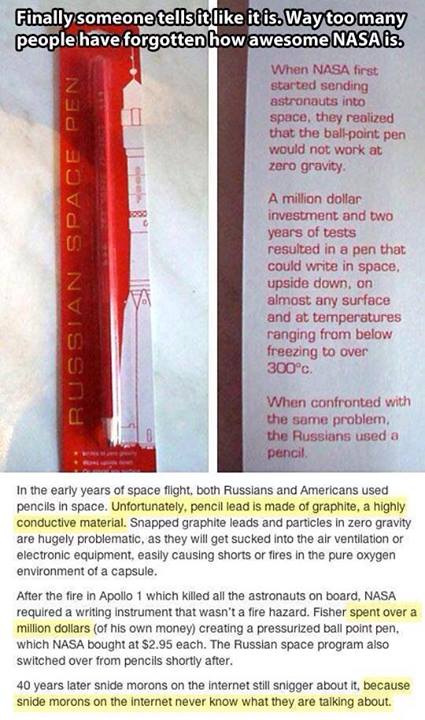I’ve often heard the story of how NASA blew millions of dollars developing a ballpoint pen that would work in space, while the Russians just used a pencil. The tale even popped up on The West Wing and in the 2004 movie Primer, but it never quite felt right. I suppose the point was to mock NASA’s large budgets and seeming inefficiency, but of all the problems with the story and the “smell test,” if you will, consider this: the moral seems to be that the Soviet space program, part of the great communist experiment of the 20th century, was somehow more efficient than the private industry-dependent American program. Ponder that for a bit.
A friend posted this picture on Facebook (h/t Paul), which led me on a brief investigation to confirm that yes, the pencil story is incomplete, if not complete bullshit:
If the above image doesn’t load, here are the highlights:
Unfortunately, pencil lead is made of graphite, a highly conductive material…Fisher spent over a million dollars (of his own money) creating a pressurized ballpoint pen, which NASA bought at $2.95 each…40 years later snide morons on the internet still snigger about it, because snide morons on the internet never know what they are talking about.
Graphite is a semimetal and an electrical conductor, used to make electrodes for some industrial processes. The risk of having little bits of conductive material floating around the inside of a spaceship was a bit too much for the purportedly bloated, inefficient bureaucracy of NASA to bear, I guess because they figured an electrical short in space would be even less efficient, and more costly in many ways, than an expensive writing implement.
The “Fisher” mentioned in the picture was Paul C. Fisher, who invented the pen on his own and then pitched it to NASA. Isn’t that the American way or something? Well, maybe not as American as selling that same product to the public:
![By Cpg100 (Own work) [CC-BY-SA-3.0 (http://creativecommons.org/licenses/by-sa/3.0) or GFDL (http://www.gnu.org/copyleft/fdl.html)], via Wikimedia Commons By Cpg100 (Own work) [CC-BY-SA-3.0 (http://creativecommons.org/licenses/by-sa/3.0) or GFDL (http://www.gnu.org/copyleft/fdl.html)], via Wikimedia Commons](http://crypticphilosopher.com/wp-content/uploads/2013/12/800px-AG-7_Space_Pen.jpg)
Photo credit: By Cpg100 (Own work) [CC-BY-SA-3.0 or GFDL], via Wikimedia Commons.


